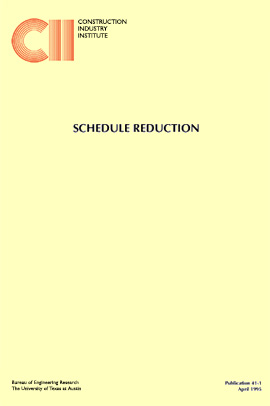
An Investigation of Schedule Reduction Techniques for the Engineering and Construction Industry
This research was commissioned by the Construction Industry Institute (CII) to provide information on schedule reduction techniques that have proven useful in the Engineering and Construction (E&C) Industry or outside the E&C Industry. The schedule reduction techniques (SRTs) are defined as the methods/processes that lead to reduction of project delivery time without increasing the overall cost.
Selection of SRTs
Previous CII research (“Concepts and Methods of Schedule Compression,” SD-55, July ’90) resulted in the identification of over ninety methods and techniques that can be applied to shorten the project delivery process. The techniques cited in SD-55 and other literature were reviewed to select a few that showed the highest potential for schedule reduction, and did not result in an overall project cost increase. Five SRTs were selected to be included in the scope of this research project. These are 1) constructability; 2) concurrent engineering; 3) cycle time analysis; 4) application of electronic media/technology in project management; and 5) early freezing of project scope.
Scope of Research
The focus of this study was to 1) document practical applications of the selected SRTs; 2) verify their potential for schedule reduction; 3) describe successful implementation steps; 4) highlight success factors (secondary contributing factors) and barriers to successful implementation; and 5) prepare recommendations for current and new users.
Research Findings
From the limited number of case studies examined (19 total) in this research the following was concluded:
- Implementation of all selected SRTs showed a strong potential for reducing project delivery time. Time reduction varied from 20% to 40% compared to historical data.
- Benefits realized by implementing the selected SRTs outweighed the implementation cost, and hence resulted in net savings or at least no net cost increase.
- More than one model may exist for successful implementation of each SRT.
- Although implementation steps may vary for each of the SRTs, it appears that several issues/trends are common to all. A number of common issues were especially observed in implementation barriers, success factors (secondary contributing factors), and lessons learned. The common issues among the SRTs can be grouped under: a) management related; b) employee related; and c) process related.
- The significance/weight of common issues under each group (i.e., management, employees, and process) may differ among the SRTs.


